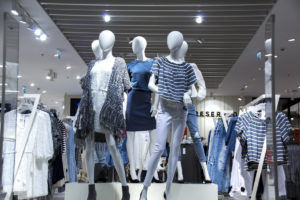 Big corporations across the globe worry about cybersecurity attacks and the repercussions those attacks have on the corporation’s bottom line. These cybersecurity attacks to their servers and information databases can be costly and can bring with them costly lawsuits as well. But, according to many analysts, employee theft and shoplifting are the more concerning issues affecting the retail industry. They alone account for more than two-thirds of their shrinkage and that figure seems to be rising every year. During the holiday season, those issues become more problematic and costly, and the retail industry looks for ways to prevent the great loses they will certainly suffer during this jolly time.
Big corporations across the globe worry about cybersecurity attacks and the repercussions those attacks have on the corporation’s bottom line. These cybersecurity attacks to their servers and information databases can be costly and can bring with them costly lawsuits as well. But, according to many analysts, employee theft and shoplifting are the more concerning issues affecting the retail industry. They alone account for more than two-thirds of their shrinkage and that figure seems to be rising every year. During the holiday season, those issues become more problematic and costly, and the retail industry looks for ways to prevent the great loses they will certainly suffer during this jolly time.
For more about this and other stories, follow the links below.
This crime in the workplace is costing US businesses $50 billion a year
There is a hidden risk facing small businesses across the country that often goes unnoticed until it suddenly rips through a firm’s finances: employee theft. It’s a crime that is costing U.S. businesses $50 billion annually, according to Statistic Brain.
Matt Ham can attest to that. He has had two run-ins with thefts by employees at his small business, Computer Repair Doctor, which has eight stores in Florida, Ohio and South Carolina, which collectively totals 30 employees.
At a store in Florida, two employees were caught stealing parts from inventory and skimming cash about a year and half ago, he said. After a thorough investigation, Ham sat them down with his attorney and they came up with a plan for restitution. Both employees had to pay back the thousands of dollars they stole. The chain has now put more safeguards in place, such as better inventory controls and a strict cash-counting process.
Survey finds no let up in one of retailers’ biggest threats
Nearly all retailers fell victim to organized retail crime during the past year. And the losses are mounting.
The survey of retail loss prevention employees found that losses averaged $726,351 per $1 billion in sales, up from $700,259 last year. Los Angeles continued to be the hardest-hit area for ORC in the nation, a position it has held since 2012. Following in order were New York City, Houston, Miami, Atlanta, Chicago, Orlando, San Francisco/Oakland, Orange County, Calif., and Northern New Jersey.
“Organized retail crime continues to be one of the biggest challenges to retailers of all sizes,” NRF VP for loss prevention Bob Moraca said. “These crimes happen across the country every day, with criminals getting smarter, more brazen, more aggressive and sometimes even attacking store employees and shoppers. Fighting ORC is a full-time job, and retailers must learn how to stay a step ahead of these thieves.”
Loss Prevention Trends to Watch During the Holiday Shopping Season
All retail eyes are focused on online security and digital transactions during the holiday season. But according to the National Retail Federation (NRF), shoplifting and employee theft accounted for more than two-thirds of inventory shrinkage in 2016. Retailers need to improve their internal security systems to boost their loss prevention abilities and keep their shrink rate from rising above last year’s historical high of 1.44 percent.
Retail store shrinkage is a known part of the industry, but with all the attention centered around cybertheft of customer information and implementing proper security measures at point-of-sale (POS) systems, the age-old problem of losing products at the physical store has taken a back seat.
Leveraging Cybersecurity Technology for Loss Prevention
Technology is playing a larger role across all retail efforts, and some of the tactics employed in the back office to protect the company’s digital data can be expanded to store-level prevention. The specifics of the skills needed differ between cybersleuths and on-the-floor store personnel, but more education and discussion between these disciplines can help.
 For many big retailers and the small mom and pop shop, the holidays are something to be excited about.
For many big retailers and the small mom and pop shop, the holidays are something to be excited about. Could it be that Santa Claus is not always a jolly, giving man? Oh yeah. Take a
Could it be that Santa Claus is not always a jolly, giving man? Oh yeah. Take a  The end of the holiday gift buying season ushers in the inevitable holiday gift return season. Clothes that don’t fit, ugly holiday sweaters no one really wanted, toys that were too old for a young child or too young for the older child all lead to returns, exchanges, and refunds. For those who have been in retail for any length of time, we know that many of these items will be returned without tags or a receipt and not even a gift receipt. It also means people will try to return merchandise to your store that was never even purchased there, despite what the customer in front of you says. This means it is prime time for those who engage in return fraud. There are so many people making returns that trying to separate legitimate refunds and exchanges from the fraudulent ones is difficult. There are steps you can take to minimize the number of fraudulent returns you accept.
The end of the holiday gift buying season ushers in the inevitable holiday gift return season. Clothes that don’t fit, ugly holiday sweaters no one really wanted, toys that were too old for a young child or too young for the older child all lead to returns, exchanges, and refunds. For those who have been in retail for any length of time, we know that many of these items will be returned without tags or a receipt and not even a gift receipt. It also means people will try to return merchandise to your store that was never even purchased there, despite what the customer in front of you says. This means it is prime time for those who engage in return fraud. There are so many people making returns that trying to separate legitimate refunds and exchanges from the fraudulent ones is difficult. There are steps you can take to minimize the number of fraudulent returns you accept. December is the month when retailers are focused on driving those end of the year sales. We push as much merchandise as possible out of the stockrooms to fill the floors. Empty salesfloor spaces should be “no-no’s” during this time of the year. We re-merchandise our fixtures to get gift ideas in front of our customers. We also take steps to increase impulse buys by filling check lanes with snacks, batteries, magazines, gift cards, etc. Managers should also be looking at last year sales information to plan schedules around peak times of the day in order to avoid long lines at the registers. While all of this is important it is just as important to start planning for your end of the year wrap up.
December is the month when retailers are focused on driving those end of the year sales. We push as much merchandise as possible out of the stockrooms to fill the floors. Empty salesfloor spaces should be “no-no’s” during this time of the year. We re-merchandise our fixtures to get gift ideas in front of our customers. We also take steps to increase impulse buys by filling check lanes with snacks, batteries, magazines, gift cards, etc. Managers should also be looking at last year sales information to plan schedules around peak times of the day in order to avoid long lines at the registers. While all of this is important it is just as important to start planning for your end of the year wrap up. A New Year is just around the corner and once again resolutions are going to be made and many of those will fall by the wayside. Why does that happen? Are goals too big to achieve? Sometimes we all start off with good intentions and we just get caught up in our normal routines and we can’t seem to focus on what it was we wanted to get done. There may be a manager out there who resolves that this is the year they will meet quarterly with each employee and discuss performance. They might do well the first quarter but then as the demands of the job take up more and more time something gives and it was the meetings. I recall one of my resolutions was to be more organized at work. I had a filing system, it was called my desktop and I knew where everything was at. I would make my resolution, create a filing system and you guessed it by the end of January I was back to my old habits. My intentions were good I just wouldn’t stay focused on it and made excuses.
A New Year is just around the corner and once again resolutions are going to be made and many of those will fall by the wayside. Why does that happen? Are goals too big to achieve? Sometimes we all start off with good intentions and we just get caught up in our normal routines and we can’t seem to focus on what it was we wanted to get done. There may be a manager out there who resolves that this is the year they will meet quarterly with each employee and discuss performance. They might do well the first quarter but then as the demands of the job take up more and more time something gives and it was the meetings. I recall one of my resolutions was to be more organized at work. I had a filing system, it was called my desktop and I knew where everything was at. I would make my resolution, create a filing system and you guessed it by the end of January I was back to my old habits. My intentions were good I just wouldn’t stay focused on it and made excuses.
 As a manager of a retail shop, the layout of the store is probably out of your hands and there is nothing to do about it.
As a manager of a retail shop, the layout of the store is probably out of your hands and there is nothing to do about it. Kleptomania is a mental disorder. Not as serious as a more severe case of schizophrenia for example, but a mental disorder nonetheless. The inability of people suffering from this disorder to stop themselves from grabbing merchandise and stealing it is a problem mental health professionals try to understand and help these sufferers find a way to overcome.
Kleptomania is a mental disorder. Not as serious as a more severe case of schizophrenia for example, but a mental disorder nonetheless. The inability of people suffering from this disorder to stop themselves from grabbing merchandise and stealing it is a problem mental health professionals try to understand and help these sufferers find a way to overcome. As the biggest shopping season of the year seems inevitable close, retailers across the world prepare themselves to not only have a great holiday season but a profitable one.
As the biggest shopping season of the year seems inevitable close, retailers across the world prepare themselves to not only have a great holiday season but a profitable one.